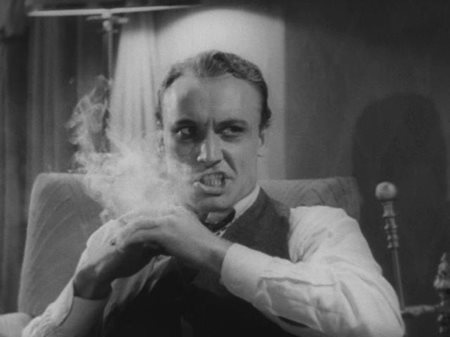 (Image via Wikimedia Commons)
(Image via Wikimedia Commons)
As pop culture popcorn goes, the cartoonish 1930’s movie
Reefer Madness is a can’t-stop-snacking delectable delight. The virulently anti-cannabis flick was created as a morality tale and financed by a church group, but now serves as a parody of a moment in time when prohibitionist drug hysteria ran rampant.
The first commissioner of the U.S. Treasury Department's Federal Bureau of Narcotics,
Harry J. Anslinger, made his views on cannabis crystal clear, strictly ideological, and very, very judgmental:
“By the tons it is coming into this country – the deadly, dreadful poison that racks and tears not only the body, but the very heart and soul of every human being who once becomes a slave to it in any of its cruel and devastating forms...Marihuana is a shortcut to the insane asylum. Smoke marihuana cigarettes for a month and what was once your brain will be nothing but a storehouse of horrid specters. Hasheesh (sic) makes a murderer who kills for the love of killing out of the mildest mannered man who ever laughed at the idea that any habit could ever get him.”
Whoa.
In the decades that followed, the global war on eradicating weed cost governments billions of dollars in revenue and countless lives, just in the interdiction of marijuana trafficking alone. Taxpayer money and precious lives lost...for what?
As a
Schedule 1 Controlled Substance, cannabis was classified in the same narcotics category as heroin, LSD, and methylenedioxymethamphetamine (Ecstasy). Schedule I drugs, substances, or chemicals are defined as “drugs with no currently accepted medical use and a high potential for abuse.” To equate the catastrophically harmful physical and mental effects of heroin and LSD to pot is like comparing the dangers of Formula One racing to lawn bowling.
Fast-forward to October 2018. The Parliament of Canada passes
Bill C-45, the Cannabis Act. Canada becomes the first major economy and just the second country in the world to legalize adult-use cannabis nationwide. And in just the 12 months since legalization, the global impact has been seismic. In early May, New Zealand's justice minister announced that a
binding referendum on legalization would be held during the 2020 general election. A series of yes-or-no questions will include options for the commercial sale and home cultivation of cannabis, although it will be up to whomever forms the next government to make the people's aspirations law.
Mexico also appears to be edging towards legalization with President Andrés Manuel López Obrador's newly released five-year National Development Plan calling the country's prohibitionist approach to drugs "unsustainable."
Last year,
South Africa's Supreme Court legalized cannabis use by adults in private places. It will be up to Cyril Ramaphosa’s African National Congress, which
won a majority in its May 2019 election, to enact legislation before the South African Supreme Court's 2020 deadline.
Belize,
St. Kitts, the Republic of Georgia, Jamaica, Argentina, Ecuador, and Colombia are among the nations that have removed or eased prohibitions on the use of cannabis in recent years.
And the U.S. is rapidly moving the same direction. Illinois Governor J.B. Pritzker (D)
announced that he has struck a cross-party deal to legalize recreational cannabis use beginning next year. If the deal sticks, Illinois will become the 11
th state with legal pot.
33 U.S. states now allow for the medicinal use of cannabis. And in April,
New Mexico became the 24th state to decriminalize marijuana, signing legislation that makes use and possession punishable by a mere $50 fine, rather than a prison term.
National U.S. polls now suggest that more than 60 percent of Americans support legalization. Even in the nation’s most conservative states,
like Texas, there is strong momentum to decriminalize weed.
And, there is now impetus afoot to legalize hallucinogens.
Residents of Denver Colorado narrowly approved a ballot initiative in May to decriminalize psilocybin (magic) mushrooms. The measure will prohibit the city from spending money to impose criminal penalties on those who consume the hallucinogenic fungus within city limits.
And in a
recent Stockhouse article, we reported on a recent investors forum and conference that discussed the potential mental health and psychological benefits of various hallucinogen substances and the potential investment opportunities in the emerging sector.
Governments, stakeholder groups, and the investment community at large have adopted a progressive, liberal approach to recreational drugs that was unfathomable even ten years ago. Recently, the U.S. House of Representatives
voted to advance legislation that would allow banks to provide services to cannabis companies in states where it is legal – a huge financial leap that could help raise billions more for a still nascent industry.
The days of muggles-crazed maniacs rampaging through the
yellow journalistic pages of Hearst newspapers must seem like a very strange relic to a well-heeled millennial professional legally purchasing a safe, federally-regulated cannabis product in an upscale boutique shop today.